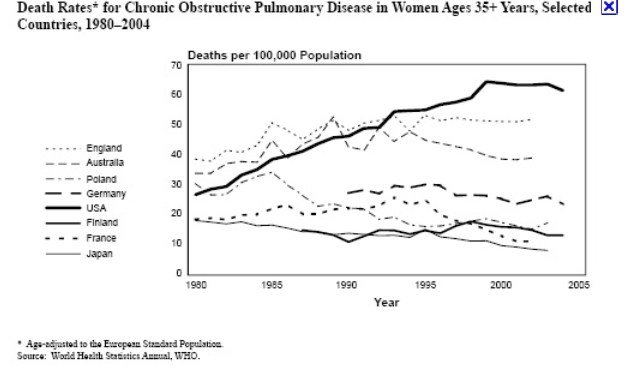Less COPD if vitamin D more than 30 ng
Low vitamin D levels do not increase the risk of chronic obstructive pulmonary disease press release
Vitamin D levels are not related to acute exacerbations of chronic obstructive pulmonary disease (AECOPD) in patients with severe COPD, according to a large prospective cohort study involving 973 North American patients. The findings were published online ahead of the print edition of the American Thoracic Society's American Journal of Respiratory and Critical Care Medicine.
In the study, a secondary analysis of data from a randomized, controlled trial of the effects of azithromycin on the frequency of AECOPD, no relationship was found between baseline Vitamin D levels and time to first AECOPD or between vitamin D levels and AECOPD exacerbation rates.
"Vitamin D insufficiency and deficiency are common in patients with COPD, and patients with severe COPD are at the highest risk for exacerbations, so we hypothesized that low vitamin D levels might increase the risk of AECOPDs," said Ken M. Kunisaki, M.D., of the Minneapolis Veterans Affairs Medical Center. "Our negative results are in contrast with earlier studies in which lower vitamin D levels were associated with higher rates of respiratory infections in adults and more frequent asthma exacerbations in children."
In the current study, mean forced expiratory volume in one second (FEV1) was 1.12L, 40% of predicted. Mean vitamin D level at baseline was 25.7 ± 12.8 ng/mL, with 33.1% of subjects categorized as vitamin D insufficient (?20 ng/mLbut <30 ng/mL), 32.0% as vitamin D deficient (<20 ng/mL) and 8.4% as having severe vitamin D deficiency (<10 ng/mL).AECOPDs were defined as a complex of respiratory symptoms (increased or new-onset) of at least 1 of the following: cough, sputum, wheezing, dyspnea, or chest tightness with a duration of at least 3 days and requiring treatment with an antibiotic or systemic corticosteroid.
During 1 year of follow-up, study subjects experienced a total of 1415 AECOPDs. Of 973 patients,360 (37%)remained AECOPD-free, 278 (29%) had 1 AECOPD, 133 (14%)had 2 AECOPDs, and 202 (21%) had 3 or moreAECOPDs.
In the primary analysis, vitamin D levels had no relationship to time to first AECOPD; for a 10 ng/mL increment in vitamin D level, the estimated hazard ratio was 1.04 (95% confidence interval: 0.97-1.12). In secondary analyses, vitamin D levels were not related to annualized rates of AECOPDs in either Poisson (p=0.82)or negative binomial analyses (p=0.87).
Patients with severe vitamin D deficiency had a higher mean rate of AECOPDs, but this difference was not statistically significant. Patients with severe vitamin D deficiency did not exhibit faster time to first AECOPD than other patients.
The study had some limitations. Vitamin D levels were only assessed at baseline, and so may have changed during the study period. Seasonal changes in vitamin D levels may also have occurred.
"Contrary to what we expected, baseline vitamin D levels were not related to the risk of subsequent AECOPDs in this large group of COPD patients at high risk of AECOPD," Dr. Kunisaki said. "Vitamin D supplementation is unlikely to have an effect on AECOPD risk in these patients."
See also Vitamin D Life
Poor sleep and lack of vitamin D - Nov 2011 need 60-80 ng of vitamin D
All items Breathing and Vitamin D 71 items as of Oct 2011
Google Search of COPD at Vitamin D Life 312 items as of Sept 2012
COPD Increasing - from NIH Factbook has the following graph

COPD patients have low levels of vitamin D - typically less than 20 nanograms

from slide presentation: https://www.Vitamin D Life.com/tiki-index.php?page_id=2269
Clinical Trials for Sleep Apnea/COPD and Vitamin D INTERVENTION
Sleep Apnea after 400,000 IU single vitamin D intervention to be completed Summer 2012
COPD - start with 6,000 IU daily for a week, then drop back to 3,000 daily
COPD - vitamin D every 60 days does not seem to indicate how much - to be completed Summer 2013
